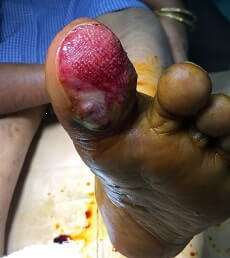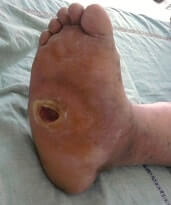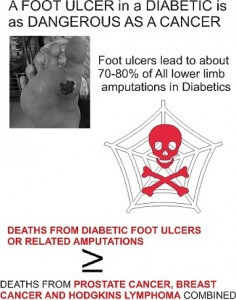MOST DIABETIC FOOT PROBLEMS START AS DIABETIC FOOT ULCERS
What are Diabetic Foot Problems?
*Common problems include
*Gangrene
Most of these problems are preventable through proper care and regular visits to your foot surgeon.
This physician can provide information on foot inspection and care, proper footwear, and early recognition and treatment of foot conditions.
Why does a diabetic get more foot problems
Foot problems in persons with diabetes : usually the result of these primary factors:
- Neuropathy leading to reduced sensation,burning and tingling
- Poor Circulation
- Decreased Resistance to infection
- Foot Deformities
Diabetes affects unfortunately all systems and often the nerves as well. The person feel reduced sensations and his chances of hurting himself and not feeling pain are high .As a result a small injury may go unnoticed and as the blood supply to the limb may also be compromised along with high blood sugars ,this little wound may not heal as quickly as a usual wound and thus worsen if not actively treated in a specialized way to take care of the special difficulty in the healing of such wounds.
If neglected the wound not only grows worse ,it may lead to some terrible complications like gangrene,severe infections and uncontrolled sugars with fever and shivering.
Foot Deformities
Foot deformities such as hammertoes, bunions, and metatarsal disorders have special significance in the diabetic population. Neuropathy places the foot at increased risk for developing corns, calluses, blisters and ulcerations. If these are left untreated, serious infections may result.
Special deformities can occur in persons with neuropathy and very good circulation. A Charcot joint, resulting from trauma to the insensitive foot, causes the foot to collapse and widen. This destructive condition is often first heralded by persistent swelling and redness, mild to moderate aching, and an inability to fit into your usual shoes. If this occurs, it is important to stay off the foot and see your podiatric surgeon immediately.


Foot Surgery in the Diabetic Patient
Realizing the potential danger of foot deformities in the diabetic patient, corrective foot surgery is an option when you are in generally good health and have good circulation. Most deformities progressively worsen over time as do the effects of neuropathy and vascular or circulatory disease. When foot deformities cannot be managed effectively with conservative care, surgery may be indicated.
Surgery may also be required to heal an ulceration or to eradicate some infections, especially those involving the bone. Patient and Caregiver cooperation is an important part of care. You must guard against injury and provide the daily care necessary to maintain the healthy feet.
Skin Grafting in the Diabetic Foot :
I do not graft the foot. I have found that with proper wound care techniques and advanced wound care modalities available today, skin formation takes place for almost all wounds. In fact I have had patients coming to me after getting skin or flap grafts and then getting ulcerations on the graft.
The main point to understand is that the skin of any other part of the body is not designed to take the pressures to which the foot is subjected. Therefore natural skin formation is usually a better alternative as that skin can definitely bear the pressure for which it was designed. Only in cases of rapid skin cover on non weight bearing areas can we justify skin grafting.

